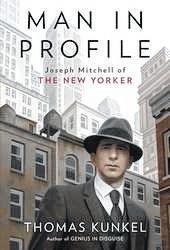


FAIRMONT — Joseph Mitchell didn’t let facts get in the way of a good story. Or deadlines, for that matter.
But none of that seems to have sullied the Fairmont native’s legacy as one of the finest literary journalists in American history. The writer is best known for a collection of profiles and color pieces he wrote for The New Yorker.
Mitchell churned out stories at a delirious pace when he joined the magazine’s staff in 1938. His output slowed to a crawl during the 1950s — he wrote only five stories that decade — before lurching to a halt in 1964, the year his final piece was published.
Mitchell famously spent the next 33 years gripped by an unshakable case of writer’s block. He went to his office at The New Yorker each day and remained on the magazine’s payroll, but failed to publish any new material before his death in 1996.
The cause of his writer’s block has remained a mystery to scholars, historians and admiring journalists. Unsurprisingly, the author of a new biography about Mitchell is a mix of all three.
Thomas Kunkel spent the past 15 years working in spurts on “Man in Profile: Joseph Mitchell of The New Yorker,” which was released April 28 to glowing reviews.
“I knew people were looking for answers, and I guess thought I would come across something that would be that magic bullet,” Kunkel said. “Something that would explain why he wasn’t producing. What was going on in his life for the past 30 years? What were the other things that were happening during that time?”
A former newspaper reporter, Kunkel now serves as president of St. Norbert College in De Pere, Wisconsin. He met Mitchell during the early 1990s while conducting research for “Genius in Disguise: The New Yorker’s Harold Ross,” his previous biography about the magazine’s founding editor.
“That’s how I got first aquatinted with Joe,” Kunkel said. “He was gracious and helpful and really supportive of the book. He couldn’t have been nicer.”
It seemed fitting for Kunkel to follow that book with a biography of Mitchell, whose attention-grabbing profiles played no small part in The New Yorker’s success.
The day after he died, The New York Times ran a half-page obituary describing the 87-year-old as a “chronicler of the unsung and the unconventional.” Always sharply dressed, Mitchell roamed the streets of New York City in search of interesting people to write about.
Subjects listed in his obituary include “flops, drunks, con artists, panhandlers, gin-mill owners and their bellicose bartenders, at least one flea circus operator, a man who sold racing cockroaches, a bearded lady and a fast talker who claimed to have written nine million words of “An Oral History of Our Times” when, in fact, he had written no words at all.”
The Big Apple was far from Mitchell’s family tree. He was raised on a tobacco farm in Fairmont, and his salt-of-the-earth father made little effort to conceal his disappointment over his son’s decision to follow his budding journalism career to New York City.
“Son, is that the best you can do, sticking your nose into other people’s business?” he lamented, but Mitchell couldn’t be dissuaded.
“Having grown up in the sticks, he had an unbelievable outsider’s fascination with New York City,” Kunkel said. “You can’t imagine a more perverse dichotomy than Fairmont, North Carolina, and Manhattan.”
It was perhaps Mitchell’s own experience as a fish out of water that allowed him to so easily spot fellow outsiders in the crowded city.
“There’s no question that if Joe had had grown up in a different environment, he certainly would have ended up in a different career or a different kind of writer,” Kunkel said. “Just imagine what it’s like to be a kid without television or radio. Not only was he in a position to interact with all these other people, but they amounted to his entertainment.”
A small shrine to Mitchell can be found at the Borderbelt Farmer’s Museum and Welcome Center in downtown Fairmont, where a collection of his books and some vintage photographs are displayed among exhibits of antique farming equipment.
“I am certain that as a young man growing up here in Fairmont he encountered his share of remarkable and unique folks,” said Charles Kemp, the museum’s co-curator and former mayor of Fairmont. “As a result, a literary seed was probably planted in his mind’s garden which sprouted as his literary work progressed.”
“Man in Profile” has received high praise from critics at The New York Times, The Wall Street Journal and The Washington Post. But the book has garnered arguably more interest for Kunkel’s discovery that Mitchell occasionally used composite characters and seemingly made-up quotes in some of his most beloved profiles.
Published with his editor’s consent, the embellishments have sparked a debate in nonfiction circles over Mitchell’s integrity as a journalist — but his biographer doesn’t seem too bothered by it.
“He is without question one of the greatest writers in American letters, period,” Kunkel said. “He’s a towering figure in terms of his talent. … Maybe the bottom line here is, however we look at the practices, we’d all be poorer if some of the stories didn’t exist.”
Kemp also feels it was a forgivable offense.
“Unlike journalists whose primary job is to relate factual news accounts of events to the public as they truly occurred Mr. Mitchell no doubt felt that his focus should be on constructing compelling stories which would cause his readers to relate to the life experiences of his characters,” Kemp said. “Less could be made of the exact surroundings or perfectly described incident, while more of the writing was devoted to the characters’ experiences within the overall story.”
“Man in Profile: Joseph Mitchell of The New Yorker” is published by Random House and can be found at most major bookstores. For information, visit penguinrandomhouse.com.
— Jaymie Baxley can be reached at 910-416-5771 or on Twitter @Jaymie_Baxley.


